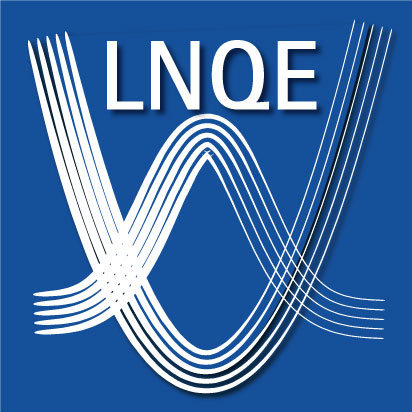Nanoscale magnetic field sensor beyond the Standard Quantum Limit

| Leitung: | C. Klempt, W. Ertmer |
| Team: | F. Anders |
| Jahr: | 2016 |
Atomic sensors allow for the precise measurement of many relevant quantities, including frequency (time), acceleration, rotation, and magnetic fields. For such measurements, the atoms are usually prepared in a superposition of two different states, in our case spin states. The quantity of interest, such as the magnetic field strength, is mapped onto a population imbalance by an interferometric protocol.
For conventional interferometric protocols and classical atomic states, the precision of such a measurement is fundamentally limited by the Standard Quantum Limit (SQL). Employing entangled atoms and novel measurement protocols, the SQL can be surpassed, allowing for entanglement-enhanced precision ultimately reaching the Heisenberg Limit in the ideal case [1, 2].
The actual enhancement due to the entanglement is however restricted by technical noise, most crucially by the detection noise (that is the ability to count the final number of atoms in the two spin states). Within this project, we already developed a novel interferometric protocol that mitigates the influence of imperfections in the detection [3]. We will also implement a better detection apparatus to finally count the atoms with single-particle resolution, allowing us to detect a large variety of entangled states.
In addition to great precision, the application as a magnetic sensor calls for a fine spatial resolution. Starting with an optically trapped atom cloud with a spread of a few micrometers, the resolution can be reduced by employing different spatially distributed states [4] or novel trap shapes.
The ambition of this project is to demonstrate the resolution of magnetic field structures below a micrometer, pushing towards the nanometer scale, measured with an outstanding precision beyond the SQL.
The figure shows a schematic visualization of the developed detection-noise robust interferometric scheme on the generalized Bloch sphere. (i) An entangled state is prepared, here leading to a state represented by an ellipse (prone to detection-noise). (ii) The interferometric protocol shifts the state. (iii) Inverse dynamics to (i) amplifies the shift (signal) and leaves us with a classical state to detect (robust to detection-noise). The protocol retains the signal-to-noise ratio and thereby the entanglement-enhanced precision.
[1] B. Lücke, M. Scherer, J. Kruse, L. Pezzé, F. Deuretzbacher, P. Hyllus, O. Topic, J. Peise, W. Ertmer, J. Arlt, L. Santos, A. Smerzi, C. Klempt, Twin matter waves for interferometry beyond the classical limit, Science 334, 773 (2011).
[2] B. Lücke, J. Peise, G. Vitagliano, J. Arlt, L. Santos, G. Tóth, C. Klempt, Detecting multiparticle entanglement of Dicke states, Phys. Rev. Lett. 112, 155304 (2014).
[3] F. Anders, L. Pezzè, A. Smerzi, C. Klempt, Phase magnification by two-axis counter-twisting for detection noise robust interferometry, arXiv:1711.02658.
[4] K. Lange, J. Peise, B. Lücke, I. Kruse, G. Vitagliano, I. Apellaniz, M. Kleinmann, G. Toth, C. Klempt, Entanglement between two spatially separated atomic modes, arXiv:1708.02480.








